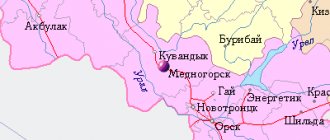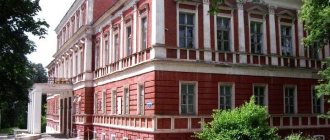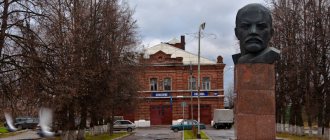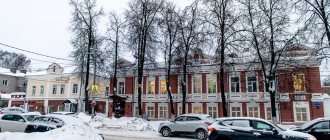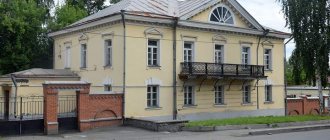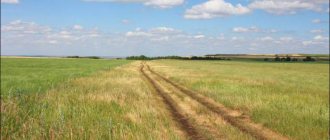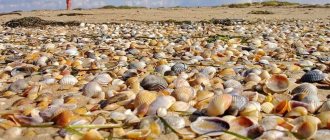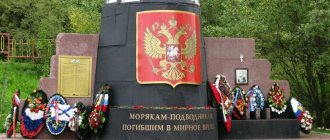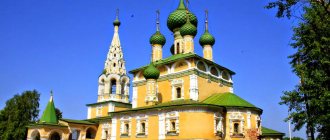Sights of Orsk and what you can see in the city?
Orsk is a small city in the Orenburg region with a long history. The territory of the city is of great interest to archaeologists; about 40 ancient settlements and relics have been found here.
Orsk is surrounded by beautiful natural landscapes. The Or River flows through the city, and the Ural Mountains rise majestically. In winter, many tourists come here to visit the ski resorts in the region.
The historical part of the city is decorated with ancient buildings and many monuments. There are two theaters in Orsk - the Drama Theater named after. Pushkin and the theater-studio "Blue Bird", which will especially please lovers of cultural recreation. Let's take a closer look at the main attractions of Orsk below.
What to see in Orsk on your own?
Interesting places and main attractions of the city and its surroundings: photos with descriptions, tips on where to go, where to go by car, what to see in one day.
Mountain "Colonel"
Within the city limits there is a mountain that has made Orsk famous throughout the world - it is here that multi-colored jasper has been mined for more than 250 years. This is a small elongated hill with an average height relative to the river of about 50 meters.
The modern name has been assigned to the mountain since the end of the 19th century, when Colonel N.V. Balk opened a stud farm on the hillside. The mountain is composed of ancient volcanic rocks, among which there are layers of jasper. In terms of color saturation and variety of shades, jasper from this deposit has no analogues in the world.
It was used as a decorative facing material in the royal bedchamber of the Kremlin, in the Cathedral of the Savior on Spilled Blood, and when decorating the Moscow Mayakovskaya metro station. Products made from local jasper are kept in the best museums in the world.
- Address: Orsk, Sovetsky district, coast of the Or river
Museum of Local Lore
The museum was created in 1937, and 2 years later it opened its doors to visitors for the first time. Initially, the basis of the museum collection was made up of geological and mineralogical exhibits; later it was supplemented and expanded by including historical and everyday objects, works of art, and archaeological artifacts.
Ancient traces of human activity were discovered in the territory adjacent to Orsk. Thousands of exhibits, from the Chalcolithic era to the Middle Ages, were excavated by archaeologists at local ancient burial grounds and are now the pride of the museum.
The collection of applied arts is also rich, which includes folk art objects of the 16th-20th centuries: crosses, folding icons, down scarves, and jasper jewelry.
- Address: Orsk, Lenin Ave., 46
Museum "T.G. Shevchenko in the Orsk fortress"
In 1847, T.G. arrived at the Orsk fortress to serve as a recruit. Shevchenko is a great poet and artist, the founder of the modern literary Ukrainian language. As a tribute to him, a museum in his honor was opened in 1986 on the site of the Orsk fortress.
The building in which T.G. lived Shevchenko, not preserved. The museum is located in a building from the early 20th century. in the place where in the 19th century. there were an arsenal and barns of the Orsk fortress. The museum's exhibitions tell about the poet's youth and early life, his time in bondage and the beginning of his creative career.
Most of the materials are devoted to the period from 1847 to 1850, when the poet was exiled as a recruit with a ban on drawing and writing in his native language. The museum contains models of the Orsk fortress of the mid-19th century, and the interiors of a peasant house and a soldier’s barracks have been recreated.
- Address: Orsk, st. Shevchenko, 33
Central Park of Culture and Leisure named after V.P. Polyanichko
The construction of a park with an area of 12 hectares was provided for by the Orsk plan of 1947. It was assumed that the park would be divided into 2 large zones: for quiet and active recreation. The park was built from 1958 to 1964 with the involvement of a large number of volunteers: enterprise workers, students and even foreign guests.
The poplars and birches planted by the Cubans are still called “trees of friendship.” Since that time, the park has become a favorite vacation spot for the townspeople.
The huge landscaped area houses more than 20 attractions for children and adults, a billiard room, a children's playground, and a cafe. You can also play paintball and visit a laser and pneumatic shooting range.
Find a suitable hotel or hostel
In 1997, the park was named after V.P. Polyanichko is a historian, journalist, and politician who died tragically in the line of duty. In the 1960s He, heading the local Komsomol city committee, actively participated in the creation of the park.
- Address: Orsk, st. Kutuzova, 1A
Garden named after A.N. Malishevsky
Before the revolution, the Archangel Michael Church and the square of the same name were located on this territory. During the Civil War, a mass grave of those killed in the battles near Orsk was placed here.
On the initiative of veterans, in 1922 the area was landscaped and turned into a garden. It was named after the Bolshevik A.N. Malishevsky, who was one of the first Soviet leaders in Orsk.
In 1953, on the site of a memorial hill in honor of the fallen revolutionaries, a monument in the form of three Red Army soldiers was erected. The park is planted with rowan trees, linden trees, acacias, and rose hips. Recently, work has been carried out to improve the garden: the flower beds have been updated, the green spaces have been put in order, and new benches have been installed. This is a quiet, cozy place for walking and reflection.
- Address: Orsk, st. January 9th
Monument to the Old Town Pie
The most original monument in Orsk was erected in 2015 on the day of the city’s 280th anniversary. Since then, it has already become one of the main calling cards of the city. The monument is a statue of an elderly woman in a scarf and apron, in one hand she has a fork with stringed pies, in the other - a bag. In front of her is a box on wheels, filled to the brim with a delicacy so beloved by residents and guests of the city.
The sale of pies turned out to be very convincing. She has a lively, expressive face, good-natured eyes with rays of wrinkles and an open smile. Tourists love to hug her and take selfies as a souvenir, especially since the height of the monument is comparable to the height of an average person.
The merchant is 165 cm tall, the height of the pedestal is 10 cm. When visiting Orsk, you should definitely try the local delicious pies and rub one of the metal pies of this monument for good luck.
- Address: Orsk, st. Kutuzova, 2
Railway station "Orsk"
The station building in Orsk was made according to the original design of the architect Tatarchuk. It was built in 1916 by captured Germans and has many features of German classicism. The tent-shaped roof, numerous spiers, and elongated windows give the structure a fabulous appearance.
This building is a state-protected architectural monument. The inside of the station is clean and cozy. There is a provincial, almost homely atmosphere here. Due to the revolution and the Civil War, the station was opened only in 1929.
The waiting room has a history corner that tells the history of this railway junction. In front of the station there is a monument to the steam locomotive model P-36.
- Address: Orsk, st. Vokzalnaya
Memorial "Aviators of all generations"
The world's first cosmonaut Yu. A. Gagarin was a graduate of the Orenburg Flight School. In 2007, in memory of this, a monument was erected in his name on the square. The monument represents the legendary IL-28 bomber, rising on a high pedestal in the shape of a star. This is not a model, but a real combat vehicle, restored by local craftsmen.
It was used for hundreds of flights from the Orsk military airfield. The monument is clearly visible from afar. The area around is landscaped. The area is paved with stone, there are flower beds and benches nearby, and there is parking.
- Address: Orsk, pl. Gagarin
Monument to workers of the Orsk Mechanical Plant
During the Great Patriotic War, the Tula ammunition plant was evacuated to Orsk. The equipment remained here in peacetime. The plant produced ammunition until the end of the 20th century. In 2005, on the 60th anniversary of the Victory celebration, a memorial was erected in front of the plant entrance.
It is a combat installation located on a reinforced concrete platform. This is an anti-aircraft missile launcher of the Uragan type, ammunition for which was produced at the plant for a long time, including during the war.
It is equipped with 20 missiles, 4 more lie at the base of the monument. Trees were planted and flower beds were built near the memorial. Not far from the landscaped park there is the Plant Workers Walk of Fame.
- Address: Orsk, Mira Ave., 2
City mansion of merchant Aksenov
One of the most beautiful pre-revolutionary buildings in the city. The mansion was built in 1910. These numbers, made of metal, adorn the only ancient weather vane preserved in Orsk, placed on the high pediment of the building.
The house is located on a slope. It is connected to Preobrazhenskaya Mountain by a stone staircase and if you look at the building from different sides, it appears to be either one- or two-story. The mansion was built for the local merchant of the 2nd guild F.G. Aksenov, but he did not live in it for long and sold it on the eve of the revolution.
Since 1930, the mansion has housed various health care institutions; now it houses one of the police units - an inquiry point. The red brick building is designed in an eclectic style and is a protected cultural heritage site.
- Address: Orsk, st. Art. Razina, 102
Apartment house of merchant Mats
Until 1912, this building housed a comfortable European-style hotel, where only the wealthiest people could stay. There was an upscale restaurant on the ground floor. The building's plan is an elongated letter "L" and has 2 exits. Built at the end of the 19th century. The house belonged to the merchant of the 2nd guild, Alexander Mats, and was considered one of the most prestigious.
After the hotel went bankrupt, the building was taken over by two banks - Siberian and Russian Commercial and Industrial. In 1919, both of them were nationalized. During Soviet times, the building housed various financial institutions; since 2003, the premises have been transferred to the Pension Fund. The house is well preserved and is of historical and artistic value.
- Address: Orsk, st. Art. Razina, 72
House of merchant Nazarov
In the old part of Orsk there is the former house of a major merchant and industrialist Vasily Ivanovich Nazarov, who played a big role in the life of the city. From 1884, for 7 years, he was a member of the city duma with the right to a decisive vote.
In 1891, I had the honor of receiving the heir to the Russian throne, Tsarevich Nicholas, in his home. 3 years after this memorable event, with his own money, V.I. Nazarov installed a memorial plaque on the building telling about this. It was taken during revolutionary times and lost.
A new memorial plaque made of marble appeared on the house only in 1998, on the 80th anniversary of the execution of the royal family. Built in 1871, the building is in need of restoration.
- Address: Orsk, st. Pionerskaya, 11
Drama Theater named after A.S. Pushkin
In the 1930s Many representatives of the technical and creative intelligentsia came to Orsk, as the city was emerging as a large industrial center. There was a need for a theater, which was created in 1937 and since then has been the center of the cultural life of the city.
Initially it was located on Sovetskaya Street, named after the October Revolution, and most of the productions were of a propaganda nature. Currently, the theater has been renamed in honor of the great Russian poet, and its repertoire is striking in its diversity.
In addition to classical theatrical performances, opera and ballet artists perform on stage, solo concerts and experimental productions are held. The theater is located in a building specially built for it according to the original design in 1969.
- Address: Orsk, Lenin Ave., 27
Church of Our Lady of Perpetual Help
This is the first and only Catholic church in the entire eastern Orenburg region. The stones for the foundation of the temple were consecrated in Astana by Pope John Paul II himself. They were carefully transported to Orsk and construction of the church began in the early 2000s. It was consecrated in 2006. It was built with donations and the help of volunteers.
The rector and nuns of the Catholic parish are from Poland. The white, neat building with red decor is pleasing to the eye. There is a wooden crucifix in the courtyard. Recently, a children's playground was installed near the church. There is a children's development and charity center at the church.
- Address: Orsk, st. Neftyanikov, 1G
Cathedral of St. George the Victorious
The main Orthodox church of Orsk is a new building, but stylized as antique. It was built in 2008-2014. A beautiful white building with many elongated gilded domes and an abundance of arched forms reminiscent of ancient Russian kokoshniks makes an elegant and festive impression.
The temple was built according to the original design of the Orenburg architect-restorer Yu.A. Grigorieva. The church was consecrated in honor of one of the most revered saints in Orthodoxy - the Great Martyr George.
He suffered martyrdom during the reign of Emperor Diocletian, but did not renounce his faith. St. George the Victorious is considered the patron saint of defenders of the native land and everyone associated with the military profession.
- Address: Orsk, st. Leninsky Komsomol, 2
Pokrovsky Monastery
A large convent existed in Orsk at the end of the 19th century. The monastery community consisted of more than 120 novices and nuns. The monastery owned many buildings, including 5 chapels. In the mid-1920s. the monastery was closed, and cavalry units were housed in its premises.
The revival of monastic life began in 1991 with the transfer of 3 buildings back to the Orthodox diocese. Currently, the Church of the Intercession of the Mother of God has been almost completely restored, and the belfry has been restored.
The temple is a majestic structure made of red burnt brick. The thickness of its walls reaches 1.5 meters. The domes on the church are dark in color, atypical for Orthodoxy.
- Address: Orsk, st. Sokolova, 85A
Temple of the Archangel Michael
The Orthodox Church in honor of Archangel Michael was built in Orsk in 1880. It was a single-domed red brick church, made in the pseudo-Russian style. The walls of the temple were strong enough and managed to survive the years of the Civil War, but in the 1930s. after several attempts to blow up the temple, it was finally dismantled to the ground.
The idea to revive the church on a historical site appeared back in 2002, but due to lack of funding, the construction of the temple dragged on for years. In 2022, the reconstructed church was consecrated and opened its doors to parishioners. The craftsmen tried to completely recreate the external and internal appearance of the temple as it was in pre-revolutionary times.
- Address: Orsk, st. Krasnoflotskaya, 1G
St. Nicholas Church
St. Nicholas Church is one of the oldest in the city. According to documents, it has been mentioned since the mid-18th century. Then it was a wooden church, which often suffered from fires. At the end of the 19th century. The temple was rebuilt from red burnt brick.
The name of the church acquired a new meaning - Tsarevich Nicholas once visited Orsk, and the year of the consecration of the temple coincides with the date of accession to the throne of Emperor Nicholas II - 1894. They did not spare money for the St. Nicholas Church and it was one of the most richly decorated churches in the city.
During the atheistic Soviet years, the church was closed and destroyed. Since 1991, work began on its restoration. Now the temple has been completely restored.
- Address: Orsk, st. Art. Razina, 100
Spaso-Preobrazhensky Church
Along with St. Nicholas Church, it is the oldest religious institution in the city, in fact its contemporary. It is located next to the St. Nicholas Church on Transfiguration Hill and is clearly visible from afar. It was first built from wood, in 1888-1894. rebuilt in stone.
In the 1930s Only the bell tower was able to survive, which became the basis for a new temple, built in 1994-1998. The two-story red brick church was built in pseudo-Russian style. It is crowned by a slender figure of eight with a tent. Together with the St. Nicholas Church, it is surrounded by a brick wall, evoking memories of the old Orsk fortress.
- Address: Orsk, st. Art. Razina, 100A
Temple of the Icon of the Mother of God “Deliverer”
The idea of creating a temple in the workers' village of Nikel near Orsk arose in the late 1990s. When work began on the construction of the foundation, a copy of the “Deliverer” icon was found on the territory of the future church. The original icon has been known since ancient times for its miraculous properties.
In 1889, the “Deliverer” was transported from Greece to the Caucasus. Based on the icon found, it was decided to name the temple under construction in her honor. The new church was consecrated in 2014, and 3 years later, a water-blessed chapel in honor of the Pochaev Icon of the Mother of God was erected on its territory.
This is also a very revered icon in Orthodoxy. It helps to heal from a variety of diseases.
- Address: Orsk, st. Kazalinskaya, 12
Monument to Taras Shevchenko
A memorial monument in honor of the great Ukrainian poet was inaugurated in Orsk on the square of the same name in 1959. Sculptor L.M. Pisarevsky portrayed T.G. Shevchenko sitting in a thoughtful pose with an overcoat thrown over his shoulder. The height of the bronze sculpture with a pedestal is 9 meters.
This monument is considered one of the most beautiful and largest monuments to T.G. Shevchenko on Russian territory. The poet spent about a year in Orsk, serving forced service as a private in the 5th line battalion assigned to the Orsk fortress. Despite the ban on creating, in Orsk T.G. Shevchenko wrote more than 20 works.
- Address: Orsk, pl. T. Shevchenko
Monument to Bogdan Khmelnytsky
The monument was erected in 1954 in memory of historical events, when the territory of the Zaporozhye army became part of the Russian state. The monument turned out to be impressive. Bogdan Khmelnytsky is depicted in full growth in a traditional national costume. In his hands he holds a mace and a whip.
The leader of the Zaporozhye Cossacks had no relation to the South Ural city of Orsk. Obviously, in Soviet times, it was decided to erect a monument to him here due to the fact that T.G. was in the city. Shevchenko and Orsk are distantly related to Ukrainian culture.
The monument managed to survive several attacks by vandals and continues to remain one of the most beautiful monuments in the city.
- Address: Orsk, st. Sovetskaya, 68
Monument to A.S. Pushkin
Erected several years ago, the monument to A.S. Pushkin is an example of elegant urban miniature sculpture. Unlike many impersonal Soviet sculptures of the great poet, this sculptural group turned out to be very lively and emotional.
Alexander Sergeevich sits on a bench next to the cat. The poet holds a pen in one hand and a book in the other. His face is inspired - as if he is composing poetry right now. I just want to sit on a bench next to the great genius and look into the open book.
The sculpture group is an ideal place for a selfie to commemorate the city.
- Address: Orsk, pl. Komsomolskaya
Memorial of Glory
The memorial complex began to be built in 1965 on the site of the mass grave of soldiers who died during the war in Orsky hospitals. Over the next decades, the memorial was repeatedly reconstructed and expanded. South Ural jasper, serpentine and other minerals are used in its design.
The central part of the memorial is the Eternal Flame with a bronze wreath. The names of city residents who died in various wars are carved on marble slabs: not only in the Great Patriotic War, but also in international conflicts of the 2nd half of the 20th century. The square around the memorial has been landscaped, trees have been planted and flower beds have been built.
- Address: Orsk, pl. Victory
Builders Park
The renovated park was inaugurated in the fall of 2022. Jogging paths, cycling tracks, and children's playgrounds were equipped here. New areas were created for graduates and newlyweds, including a beautiful rotunda and art objects for photo sessions. The beach area was equipped, including a beach volleyball court.
Pedestrian alleys are paved with paving stones, and new installed lighting allows walking in the evening. The park was created according to all the rules of a comfortable urban environment and is an excellent place for family recreation and sports.
- Address: Orsk, st. Dokuchaeva, 8
Search for a hotel in this city
Orsk: areas, recreation, excursions, museums and churches, cuisine and restaurants, shopping and shops, attractions of Orsk.
In the Orenburg region, at the foot of the Ural Mountains, stands the city of Orsk, which at the very beginning of its history was also called Orenburg. Despite the fact that this is a regional town with a population of just over 200 thousand people, it is one of the ten largest cities in Russia by area and ranks 7th after Moscow, St. Petersburg, Volgograd, Perm, Ufa and Tyumen. (By the way, the capital of the region, the city of Orenburg, is only in 53rd place in this list.)
Orsk combines the European-style New Town and the Old Town, where the influence of Asian culture is felt. The natural separator between these parts is the Ural River.
A little history
The establishment of a new settlement was proposed by the Kazakh foreman Abulkhair Khan, who led the process of annexing the Kazakh zhuzes to the Russian Empire. Near the fortress there was Mount Preobrazhenskaya, where the builders erected one of the main citadels of the future city. In 1741, the fortress began to be called Orskaya, and the previous name was assigned to a new settlement being built downstream of the Ural River.
For a long time, the Orsk fortress was not only an important military fort in the Urals, but also the epicenter of trade with the states of Central Asia. In 1782, it became the administrative center of Orsk district, part of the Orenburg region. Until the 1840s Massive construction of the fortress continued: new bastions, churches were erected and shopping arcades were opened. In 1852, the fort was transformed into a village of the Cossack army of the Orenburg province.
After 13 years, the former fortress became a city. In 1881, a freight road was built near Orsk, which contributed to the opening of new trading posts and small factories. From this period, peasants from neighboring villages and representatives of the merchant class began to move to the city en masse. By the end of the 19th century, the city's population was 13,000 people. People were mainly engaged in trade, selling handicraft, industrial and agricultural goods.
In 1900, philanthropist M.E. Smirnov opened a confectionery factory in Orsk. Gold deposits were also found near the city, which attracted a huge number of merchants and entrepreneurs. As a result of the development of the gold mining industry, the Orsk railway station was opened in 1913, serving to deliver the precious metal to other regions of the country.
After the revolutionary events of 1917, the city became one of the Bolshevik strongholds in the Urals. During the Civil War, it was besieged by the troops of the White movement. After the end of hostilities, Soviet power was finally established in Orsk.
In the early years of the Soviet Union, many enterprises and transport hubs temporarily suspended operations in the city. But during the period of collectivization and industrialization, the economy of Orsk was restored: the construction of new conveyors and workshops began, and the railway station resumed operation. As of 1939, the city had an oil refinery and metallurgical plant, a meat processing plant, and a thermal power plant.
During the Great Patriotic War, 8 hospitals for the wounded were organized in Orsk. Special settlers from Ukraine, Belarus and the Baltic states were evacuated here. Many of them continued to live here after the end of hostilities and increased the city's population. In the post-war years, many factories opened in Orsk, which improved the city’s industrial production by 200%. In 1971, Orsk received the Order of the Red Banner of Labor for its enormous success in the development of the industrial sector of the economy.
After the liquidation of the USSR, the vast majority of enterprises in Orsk closed, which led to economic decline. Due to unemployment and low living standards, residents began to leave the city. As a result, the city's population has decreased by 42,000 people and in 2022 there are fewer than 230,000 inhabitants. Despite this, Orsk remains one of the most developed industrial cities in the Volga Federal District.
How to get there
- by train
A railway passes through Orsk, connecting it with the central cities of Eastern Orenburg, so getting here is quite easy - especially since there are 5 railway stations in Orsk. For example, you can get to Orsk by train from Orenburg for 950-1700 RUB. Prices on the page are for October 2022.
- by car
From Orenburg you can get to Orsk along the P336 highway (the journey will take about 3.5 hours).
- by plane
You can also fly from the regional capital to Orsk by plane; the travel time is 1 hour 20 minutes. Flights depart from Orenburg Airport 6 days a week; a ticket can be purchased for 935 RUB.
Search for flights to Orsk
Entertainment and attractions of Orsk
Orsk is divided into three districts: Leninsky, Oktyabrsky, Sovetsky. City buildings are embedded in picturesque landscapes: the Or, Ural, Elshanka and Bolshoy Kumak rivers, mountain peaks, gardens and sprawling parks. The symbol of the Old Town is Preobrazhenskaya Mountain, surrounded by the streets of L. Tolstoy, Stepan Razin, Engels and the Parisian Communards. Wax wax and variegated jasper are mined there, and on the top of the mountain the gilded temples of the Spaso-Preobrazhensky and Nikolsky shine.
The historical center of Orsk is decorated with cozy old buildings and many monuments. The complex layout of the Sotsgorod district was invented by Hans Schmidt, who turned it into a complex of industrial and residential buildings. There are two theaters in the city: a drama theater named after A. S. Pushkin (Lenin Prospect, 27) and the Blue Bird theater-studio.
Religious buildings
The Transfiguration Church is the first church to appear in Orsk. During the war years, the temple, located on a hill, was not only the center of spiritual life, but also an observation post. Another religious building that deserves attention is the temple of the Orsky Convent (late 19th century). From a number of numerous buildings, the priest's house and the stone church have been preserved, 5 small domes and one large one have been restored, and the bell tower has been erected again.
Orsky railway station
Orsky railway station is recognized as an architectural and historical monument. The building was designed and built by Germans who were captured after the First World War, so its style is defined as German classicism. On the station platform there is a monument - the P36 steam locomotive, which ran through the Orenburg region from 1934 to 1964.
The main attractions of Orsk that are worth visiting
- The Iriklinskoye Reservoir is one of the largest artificial reservoirs in the Southern Urals. The width of the reservoir reaches 8 kilometers, and the coastline reaches 400 kilometers. The reservoir was founded to provide residents of Novotroitsk and Orsk with drinking water. A hydroelectric power station was built on the territory of the reservoir, providing the region with energy.
The reservoir filled with water for about 10 years, forming three large bays. Today the Iriklinskoye Reservoir is a popular place for fishing; carp, bream, carp, ide and many other species of fish are found here.
In the summer, the shore of the reservoir is strewn with tourists and local residents who come to relax and swim on their own, or while relaxing in one of the local sanatoriums.
- Iriklinskaya HPP is one of the large hydroelectric power stations in the Southern Urals. The hydroelectric power station was built together with the reservoir since 1949. Construction took place under difficult conditions. 10 years later, the first launch of the hydroelectric power station took place.
Construction and improvement of the hydroelectric power station took place until 1979. Today the power of the station reaches 2400 MW.
- The Naurzum Nature Reserve, with an area of about 200 thousand hectares, consists of three protected zones. The territory of the reserve stretches all the way to the steppe zones of Northern Kazakhstan.
The reserve includes dry meadows, pine forests, steppes, fresh and salt lakes. The reserve grows many types of vegetation unusual for steppe zones. Pine and mixed forests are intertwined here; some plant species are listed in the Red Book. The reserves are home to hares, wild boars, moose and other species of mammals, as well as 280 species of birds.
The Naurzum Nature Reserve has been included in the UNESCO World Heritage List since 2008 and is a natural monument of world significance.
- Mount Colonel rises on the banks of the Or River. The name of the mountain is associated with a stud farm that was located on its slope at the end of the 19th century. The plant was maintained by a retired Cossack colonel.
The mountain gained popularity thanks to the deposits of Orsk jasper. This material was used in the construction of the royal bedchamber in the Kremlin, the Mayakovskaya metro station in Moscow, and the Church of the Savior on Spilled Blood in St. Petersburg. Products made from Orsk jasper are in the Hermitage, in Russian museums and in foreign collections.
Anyone who climbs the mountain will see a panoramic view of the surrounding area. And memorable photos on the mountain will again transport you to the top.
· Polyanichko Central Park of Culture and Culture - a park complex with an area of 11.5 hectares, founded in 1958. The park is named after local resident Polyanichko, who was active in ending the fighting in Afghanistan.
Today the park has more than 20 modern attractions, of varying levels of difficulty, for different ages, a visit to which will especially delight children. The park also features children's playgrounds, sports fields and entertainment. After an active holiday, it is worth visiting local restaurants and cafes.
In addition to the culture and recreation park, in Orsk it is worth visiting the Malishevsky Garden and Builders Park. These are favorite places for walks among local residents and city visitors.
- The Yubileiny Sports Palace is the only structure with artificial ice in the entire Orenburg region. Sports competitions are often held here; the palace's capacity is 4,500 spectators.
On days when there are no competitions at the Sports Palace, you can visit the skating rink and have fun. On the second floor of the complex there is the only sports museum in the region, which is also worth a look.
- The Museum of Local History in Orsk presents exhibitions dedicated to the history of the local region. Here you can see objects of fine art, objects of applied art, as well as household items of ancient settlements.
In 2010, the museum underwent reconstruction, as a result of which the museum became the most modern in the region. The museum is equipped with modern technology, and the tours are interactive and innovative, which is especially interesting for children.
- The T. G. Shevchenko Museum is located in the Orsk fortress. It was in the Orenburg region that the poet served in the military as an ordinary soldier. Among the museum's exhibition you can see the poet's books, paintings, documents, national Ukrainian clothing and household items.
The museum recreates the interior of the barracks and guardhouse of the 19th century, a diorama of the Orsk fortress and a copy of Shevchenko’s ransom letter from the serf bondage.
In Orsk, many ancient buildings have survived, recognized as architectural monuments of the 19th and early 20th centuries.
Orsky Station occupies a special place in the city's architecture. The building was built at the beginning of the 20th century, but there were problems with the timely opening of the station due to the civil war. The station building was designed and erected by captured Germans who remained in the region after the First World War.
Today the station building, erected in the style of German classicism, is an architectural monument. And the station platform is decorated with a steam locomotive that ran through the Orenburg region from 1934 to 1964. This is the first attraction of Orsk, welcoming tourists and guests of the city.
There are many religious buildings in Orsk. Many of them have survived from the end of the 19th century, some were erected not so long ago.
Museums of Orsk
You can learn more about the history of the city at the local history museum (city center, Lenin Ave., 46). Here you will see large collections of applied and fine arts, archaeological finds, and numismatics. Curious household items are also presented here, from antiquity to our time. Pay attention to the exhibition “Secrets of the Valley of the Amazons”, exhibits of which were found in the Orsk region. Children are entertained on an excursion-game “Russian Upper Room”, where they talk about the life of their ancestors in a playful way. The museum is open daily, except Sunday and Monday, from 10:00 to 18:00.
The branch of the museum in the Old Town is famous for its exhibition dedicated to Taras Shevchenko. The Oktyabrsky district administration building allocated part of the premises for a permanent art gallery.
Parks
There are several large parks in Orsk: the Park of Culture and Recreation, the Builders Park and the Malishevsky Garden. This is a wonderful place for long walks - clean forest air and silence, broken only by the singing of birds and the sound of children's laughter.
The Memorial of Glory is a famous place in the city. A bronze plaque lined with a black-green serpentine with an inscription, in front of it is the Eternal Flame, marble slabs on which are inscribed lists of those killed in wars and bronze busts of ten Orchans - heroes of the Soviet Union and Russia.
Neighborhood
Archaeologists are studying the area around Orsk far and wide: about 40 ancient settlements, as well as burial mounds and single mounds, have been found here. For example, in the Kumak burial ground, scientists found Bronze Age burials, and in a Sarmatian mound of the early Iron Age (7-6 centuries BC) - an Egyptian vessel with the name of the Persian king Artaxerxes the First. This is only the 6th such vessel in the world.
In winter, lovers of alpine skiing and snowboarding come to Orsk to conquer the southern slopes of the Ural Mountains. Not far from the city of Kuvandyk, 100 km from Orsk, the Dolina ski resort was built.
5 things to do in Orsk:
- In the local history museum, admire the amazing jasper stone, which depicts V.I. Lenin in a cap, with a mustache and goatee.
- Have dinner at the Yashma cafe on Lenin Avenue, 24, which has been operating since 1965 and has become one of the main meeting places in the city.
- Take an excursion on an airplane with the Swifts flying club and jump with a parachute.
- Take a look at the unique children's art gallery.
- Take part in a paintball tournament in the Central Park of Culture and Leisure named after Polyanichko.
Main attractions
The sights of Orsk are concentrated in the southern and central parts of the city. Most of them were built in the 19th century. In the 90s In the 20th century, many cultural and historical sites fell into disrepair. But gradually the city authorities were able to restore all the sights. Now Orsk is a popular tourism destination , attracting travelers mainly from other regions of the Russian Federation.
Local residents first recommend visiting the city Drama and Comedy Theater. This cultural institution was founded in 1937. During the war years, theater actors performed for soldiers and wounded in hospitals to increase morale. After the Great Patriotic War, many Soviet and Russian troupes and actors performed here, including Alla Vasilievna Kozelskaya. Currently, ballet performances, solo concerts and academic productions are organized on the theater stage. In 2014, a major renovation of the theater building was completed, which made it possible to attract new spectators.
All tourist routes in Orsk necessarily include the Central Park of Culture and Recreation, which occupies an area of 12 hectares. This complex is the main place of the city where you can spend your leisure time. There are dozens of attractions, sports grounds, swimming pools and bike paths here . The park is ideal for family holidays ; it has many themed cafes and play areas for children. Among the special entertainments, it is worth highlighting the halls for playing billiards, as well as a large shooting range with a huge arsenal of pneumatic and laser weapons.
In the Old part of Orsk there is a local history museum. It is named after the famous Ukrainian revolutionary writer Taras Shevchenko, who visited the Orenburg region several times throughout his life. The museum building is divided into 3 rooms. The first hall houses the poet’s main paintings and literary books dedicated to the Urals and the Orenburg region. The second room contains the main documents and manuscripts belonging to Taras Shevchenko. The third room houses the personal belongings of the great Ukrainian writer, including his personal clothes and jewelry.
For a fee, museum employees conduct tourist excursions around the museum, where they talk in detail about each exhibit, mentioning interesting facts from Shevchenko’s biography.
The main cultural attraction of Orsk is the Transfiguration Church. It was founded at the beginning of the 16th century and was a small wooden temple located at the highest point of Preobrazhenskaya Mountain. After the formation of the Orsk fortress, the church was destroyed due to fire. The restored temple was built from stones, which increased its stability and strength.
The building of the Transfiguration Church is made in the ancient Russian style, combined with elements of modern Gothic. During the Civil War, there was an observation post of the Red Army here. Now the temple continues to operate, and services are held there during religious holidays.
The most famous military monument in Orsk is the Memorial of Glory. It is dedicated to the citizens of Orsk who fought on the fronts of the Great Patriotic War and participated in hostilities in Afghanistan and Chechnya. The monument is a large mass grave with the ashes of Soviet soldiers. According to official data, more than 263 residents of Orsk are buried here.
Weather in Orsk
- Today
- Tomorrow
- October 5, Monday Clear +9 °C during the day +3 °C at night
- October 6, Tuesday Clear +11 °C during the day +2 °C at night
- October 7, Wednesday Cloudy, light rain +11 °C during the day +6 °C at night
- Weather for 2 weeks
Orenburg region
- Where to stay: in the regional capital Orenburg or at the Russian equivalent of the Dead Sea - in Sol-Iletsk.
- Where to go: to the capital of the Orenburg region - the city of the down scarf Orenburg or to the unique lakes of Sol-Iletsk. It is worth visiting the “cradles” of Orenburg oil and the oldest cities of the Southern Urals - Buguruslan or Buzuluk. In addition, you can see the endless steppes of the Orenburg Nature Reserve, visit the Kamsak Gorge, or go to the homeland of the author of “The Scarlet Flower” in Aksakovo.
- You may also be interested in Greece, Türkiye, Abkhazia, Germany, Finland.
- The most popular Russian cities and regions: Golden Ring, Kazan, Moscow, St. Petersburg, Sochi.
The city of Orsk is located in the Orenburg region. It includes Leninsky, Oktyabrsky and Sovetsky districts. The area of the city of Orsk is 58.4 thousand hectares.
Orsk ranks 80th in terms of population in Russia - 239.8 thousand inhabitants, most of whom are Russians; in addition to Russians, Ukrainians, Tatars, Kazakhs, Germans, Bashkirs, Belarusians, and Chuvashs live in the city.
The city is divided by the Ural River into two parts - the New and Old Town (European and Asian parts).
Orsk is considered the second largest industrial city in the Orenburg region. Among the main industries are: non-ferrous metallurgy, mechanical engineering, petrochemicals, food and light industry. The popularity of Orsk was brought by such enterprises as: the Yuzhuralnickel plant, the Orsk Machine-Building Plant, the Orsk Electrical Products Plant, the Orsk Refrigerator Plant, as well as the Orsk Wagon Plant and the Sarmat Machine-Building Association.
In Orsk there are educational institutions such as the Orenburg State Institute of Management (branch), a branch of the Moscow Institute of Law, the Russian University of Innovation (branch), a branch of Chelyabinsk State University and others. In total, there are 46 schools in Orsk. There are many hotels in Orsk. The pride of Orsk is the Orsk State Pedagogical Institute, as well as a branch of the Orenburg State University and a branch of the Orenburg State Institute of Management, as their students take prizes in regional and all-Russian Olympiads. The Orsky State Drama Theater named after A.S. plays an important role in the fate of the city. Pushkin, as well as a local history museum, a children's art gallery, the Blue Bird children's folk theater, and an archaeological research laboratory. A favorite place for local youth is the Vstrecha theater studio.
Another pride of Orsk is the Yuzhny Ural hockey team, which plays its home matches at the Yubileiny Sports Palace, which has a total capacity of 4,588 seats.
The city of Orsk is currently an industrially developed city in the Orenburg region, a city with a large number of architectural and historical monuments.
Since Orsk is one of the major transport hubs in Russia, numerous passenger and cargo transportation is carried out through it. The main directions of railway communication: railway - centers of Eastern Orenburg region; highways - with Orenburg (republican significance) and with Aktobe (formerly Aktyubinsk); There is an active network of public roads.
The natural plateau of Orsk is very heterogeneous and diverse. In close proximity to Orsk there is a large man-made sea - the Iriklinskoye Reservoir. With its appearance, floods in Orsk decreased. The idea of constructing the reservoir included the need for water supply in the central and eastern parts of the Orenburg region. The first flows of water entered the reservoir on April 17, 1958 and the last on May 8, 1966, at which point the design mark reached 245 meters above sea level. To cover the shortage of electricity acquired after the construction of the hydroelectric power station and dam, the construction of a large thermal power plant began. For this purpose, a site was chosen on the shore of the reservoir, namely in the Novoorsky district. The first stone in the construction of GRES was laid in the spring of 1963. In December 1975, the working village of Energetik and the power plant were put into operation.
On the western side of Orsk rise the spurs of the Ural Mountains, striking in their beauty and breadth. Snow-covered ski slopes with magnificent nature are suitable for ski tourism. Many different mountain herbs and trees grow in this area; in the spring you can see wild tulips. Basically, in these places the weather is pleasant, since there are more cloudless, sunny days a year here than on the Black Sea coast.
The crisis in the ecological state of the environment in Orsk directly depends on industrial pollution. The air in Orsk is considered the most polluted in the Orenburg region.
The main environmental pollutants are:
Yuzhuralnickel plant. It is the largest enterprise in the production of non-ferrous metallurgy. The emissions mainly contain nickel, sulfur dioxide, and carbon (IV) monoxide.
Oil refinery named after Chkalov. Engaged in the production of gasoline, diesel fuel, kerosene, and fuel oil. Emissions into the atmosphere - methane, carbon monoxide (IV), hydrogen sulfide, phenol.
. Engaged in the production of products for organic synthesis chemistry. Pollutes the atmosphere with sulfuric acid. Combine "Ural Steel". It has a negative impact on the atmosphere through emissions of hydrogen sulfide, ammonia, sulfur dioxide, carbon monoxide, and phenol.
Several areas fell into the zone of active release from industrial enterprises:
- intersection of Stanislavsky and Mira Avenue (copper);
- area of the “Cinema Mir” bus stop (copper);
- Pervomaisky village (copper, sulfur dioxide);
- area of the Severny microdistrict (calcium, sulfur dioxide).
The problem of clean drinking water has been solved in Orsk; the population is provided with a sufficient amount of standard quality. According to the State Center for SES of Orsk and the department of standardization and metrology: groundwater mineralization is from 0.3 to 0.7 g/cub.dm. In terms of hardness, the water is very soft, exceeding the maximum permissible concentration is not observed.
In Orsk there is a cluster of mineral deposits: dolomite, nickel, titanium, chromium, asbestos, manganese, tuff, clay, jasper, which are used in industrial metallurgy, construction, and in the manufacture of souvenirs. The world-famous variegated pit is the pride of Orsk. The deposit (Colonel Mountain) is located within the city. Orsk jasper is represented in all colors, with the exception of pure blue. The most perfect are landscape and patterned jasper; when polishing the stone, you can see some unimaginable design or picture. Most mineral resources are non-renewable species.
Geography and infrastructure of the city
Now the area of Orsk is 630 square meters. km. It is included in the ranking of the 100 most populous cities in the Russian Federation; it is difficult not to notice it on the map. The city is located 290 km from the regional center of Orenburg and borders on the settlements of Novotroitsk and Novoorsk. Orsk is divided by artificial canals, as well as the Or and Ural rivers into European and Asian parts. It is located in the UTC+5 time zone, the time difference with Moscow is 2 hours.
Due to the fact that a large number of oil refining and metallurgical enterprises are concentrated in Orsk, it is not news to anyone that the city is included in the list of the most polluted places in modern Russia. A lot of waste from the processing of nickel, copper and iron ores is released into the atmosphere. The following enterprises produce the largest amount of emissions:
- Yuzhnouralsk Nickel Combine
- South Ural Machine-Building Plant.
- Orsky Meat Processing Plant.
- Orsknefteorgsintez.
The unfavorable environmental situation negatively affects people, which is why life expectancy in Orsk is lower than the national average.
The city's climate is characterized by high temperature differences. In winter, temperatures can drop to -45°C. In summer it rises to +40°C. In the warm season, judging by the description in guidebooks, there is increased aridity, which gives way to excessively wet winters. Such climatic conditions are determined by the location of the city - Orsk is located in a sharply continental zone, characteristic of steppe areas.
In spring, a large amount of snow begins to rapidly melt, which leads to an increase in water levels in rivers. For this reason, floods often occur in Orsk. But the coastal streets are protected from water flows by massive dams built along the entire perimeter of the city.
Orsk is officially divided into 3 administrative districts:
- Sovetsky - includes the southern part of the city.
- Oktyabrsky - consists of the northeastern and western parts of the city.
- Leninsky - unites the eastern and central parts of the city.
The last Leninsky district has the most developed infrastructure; the main cultural and historical attractions of Orsk are concentrated in it. In the very center of this administrative unit there are banking institutions, the city administration, as well as office blocks. Also in this place of the city the best security is provided for residents and tourists. There are police strongholds on every street, and there are surveillance cameras on buildings. In the eastern part of the Leninsky district there are new multi-storey buildings with landscaped courtyards. For this reason, housing in this area is more expensive than in the rest of the city.
The Sovetsky district contains the main monuments and oldest buildings of Orsk, including Orthodox churches with unique carvings. A large number of schools and colleges are also present in this part of the city. The most disadvantaged is the Oktyabrsky district, built up with five-story panel houses. The largest number of crimes was recorded here.
On the outskirts of Orsk there is a private sector where summer cottages and holiday homes are located. These parts of the city are located closest to manufacturing enterprises and metallurgical plants. Therefore, the air on the outskirts of Orsk is considered the most polluted in the city. There is an increased risk of contracting lung and heart diseases.
